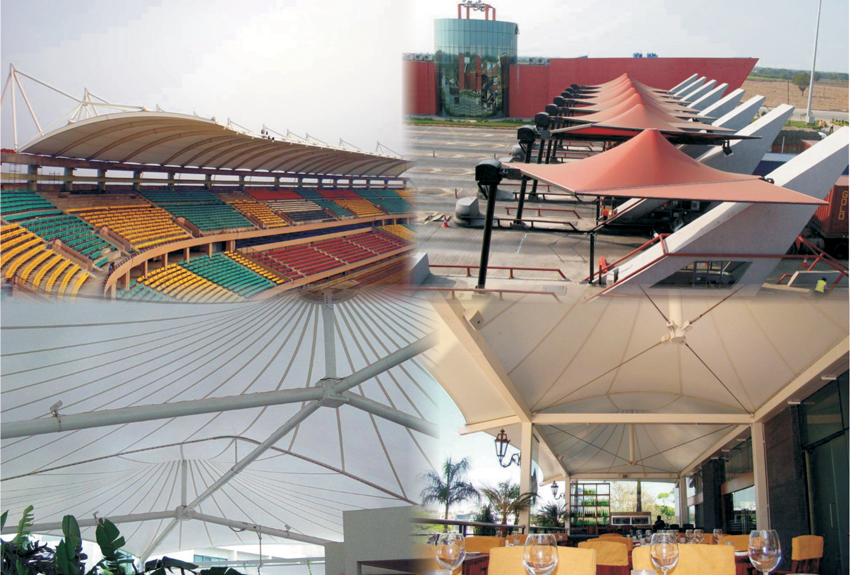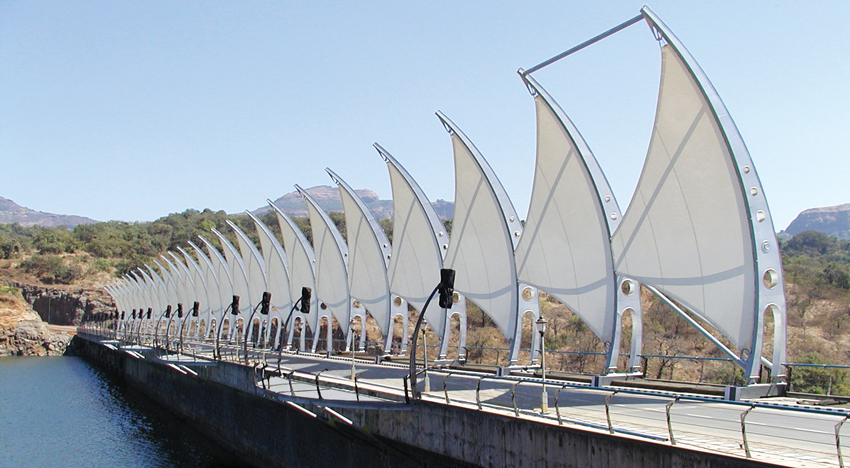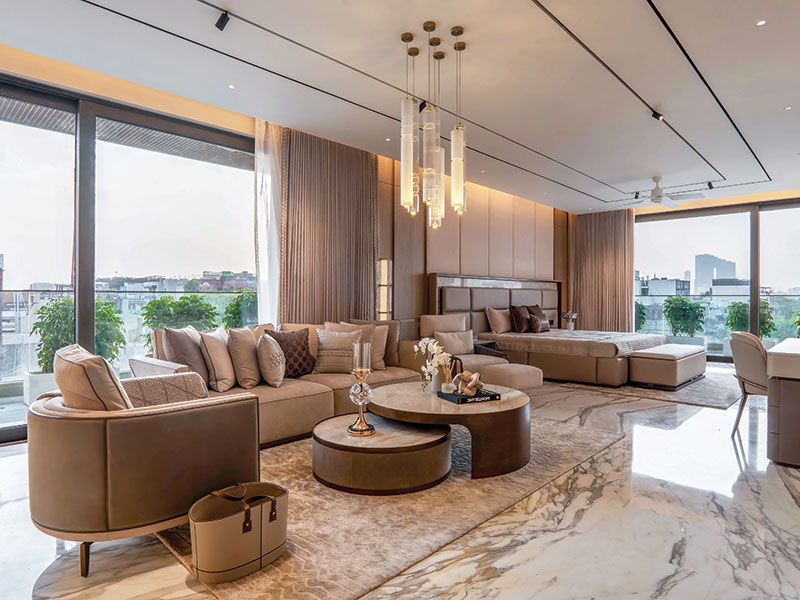
Tensile membrane structures are exciting, practical and cost-effective options to cover new or existing areas to provide shade and shelter. They are flexible and light weight structures and can be moulded in any shape and size to meet the specific need in given environment. Tensile membrane structures are most often used as roofs as they can economically and attractively span large distances. They can also act as canopies, skylight, and covered walk- ways, shading systems or atrium roofs, reports, Maria R.
Tensile structure is not a new concept but is probably one of the oldest methods used to provide protection from adverse climatic conditions. Evidence confirms that people have been making tents for at least 15,000 years, initially using animal skins. In due course of time man also learned to use woven fabrics for the purpose. The military have been long known for using the tents as a valuable structures in battle fields. Tents are easy to erect and disassemble, are relatively weather-tight, and lightweight too.
Possibly, ancient Egyptians were the first civilization to use pieces of fabric for shade. They also found sails useful for harnessing the wind power to travel in sailing boats way back in 3,500 BC. Greeks and Romans also used large pieces of fabric in their buildings. Actually, Romans used large canvas "sails" to provide shade to spectators at the Colosseum in Rome pulled into place by sailors.
Modern technology has terribly transformed the way these tensile structures are made. In addition to being more weather-proof and lighter in weight than sticks and animal skins, modern fabrics offer advantages such as protection from ultraviolet (UV) radiation and greater wind resistance. They are also coated with materials that resist UV degradation.
A tensile structure can be thought of as an umbrella and create tension in different ways, depending on the size of the area that needs to be covered. In a basic pup tent, tension is created by the poles on which the frame of the tent rests. In the case of larger structures, more durable material such as fiberglass-coated polyurethane is used to provide structure integrity. Usually, these structures also have as their base lines of steel cable forming a cable net, giving the structure its shape while allowing it to be flexible at the same time. There are even some tensile structures that do not need any supporting framework whatsoever. In this case, pressurized air is used to create the needed tension.
Tensioned membrane material is considered to be the fifth construction element after metal, stone, glass, and concrete and today the popularity of this material is growing throughout the world. Modern fabric materials in modern architecture can shape space, enabling architects to sculpt 3-dimensional areas in a manner that is not possible with any other type of material. Some of the famous membrane architectures are
the Millennium Dome, London, Denver International Airport terminal, Aintree Racecourse, Liverpool, U.K and so on. India too is not far behind in the use of this modern construction material. Mumbai Airport, Hyderabad airport, Deer Park Himachal Pradesh, IMTMA Bangalore International Convention Centre and so on are the prime examples where tensile fabric structres have extensively been used.
Realizing the growing potential of Indian Market, many world-known Fabric manufacturers are operating in India through their distributors and providing multiple of choices in Fabric for tensile structures. Companies like Mehler and Versadage of Germany and France-based Ferrari have even opened their offices in India. Other major companies which penetrated in India include Grorich Tentsystems Pvt Ltd., Skybridge structural Industries, Taiyo Membrane India, Structurflex, etc.
Tensile Fabrics
'Tensile Fabric' is a term used simply to describe a fabric that is under tension i.e being pulled in opposing directions and can take any form, though is generally based around three shapes, the cone, double curve barrel vault and the Hypar (Hyperbolic shape). Tensile structures are designed to sustain wind pressure, temperature fluctuations, rain, and solar radiation and require minimum structural support.Different Fabric Choices

As far as form, appearance, longevity and application areas are concerned, many types of fabrics are used in making tensile structure such as cotton fabrics, coated glass fabric, PVC coated polyester, Teflon coated glass, acrylic coated cotton, cotton canvas, PVC on polyester mesh, Nylon rip-stop (spinnaker fabric) and so on. But two fabric membrane types that are commonly used in tension fabric structures are: PVDF/PVC Coated Polyester (Polyvinyl DeneFlouride), and PTFE Coated Fiberglass (PolyTetraFluoroEthylene).
PVC Coated Polyester
This material is being widely used for fabric structures for over twenty years. It is easily handled and welded using fabric structures high frequency welders. The PVC coated polyester fabrics offer significant cost advantages over PTFE coated Fiberglass fabrics. Life span of PVC coated polyester architectural fabric should exceed fifteen years and is fire rated to BS 5867. It will not support combustion and will not produce flaming droplets.Based on surface coatings, PVC fabrics are classified into:
(a) Acrylic-Typically used where the fabric is colored. This type of fabric does not have as good properties for self cleaning or for life expectancy as compared with PVDF or PTFE fabrics. Acrylic coated can be welded conventionally without any surface treatment. Warranty 3-5 years.
(b) PVDF (Polyvinyl DeneFlouride) coating-This coating has excellent theoretical properties for long-term clean ability and protects the PVC and polyester. All architectural fabric should be specified with antiwick base fabrics. Wicking is the problem where water creeps internally along the thread lines of the fabric leading to unsightly staining of the fabric and possible de lamination. Warranty 7-12 years.
PTFE (Poly Tetra Fluoro Ethylene) Coated Fibreglass
PTFE is chemically inert and offers excellent self cleaning properties, fire resistance and life span typically exceed twenty five years. This coated Fiberglass is very expensive but is competitive with glass. The main problem with PTFE is that it requires very careful handling during the construction phase. The installation of PTFE coated Fiberglass fabric requires much more care and more complex detailing than the PVC coated polyester fabrics.The fabric for tension fabric structures is not weldable with conventional high frequency equipment but uses a special iron. Particular properties of PTFE allow it to be welded and unwelded using the same machinery. This allows damaged panels to be repaired on site. PTFE coated glass is fire rated to BS 476 Part 7 Class 1 and Part 6 Class 0.
Selection criteria of Fabrics
Many factors are to be kept in mind while selecting fabric for a particular application. These are presented below.- Fire performance - The fire performance of a membrane depends on the base cloth and the seam details. All membranes will de-tension under high temperatures. Speed of this process depends on temperature and pre-tension in the membrane. PVC/polyester will creep at around 70-80 deg C and seams will start peeling apart at around 100 degrees. At 250 deg C the PVC membrane will melt back from heat source creating vent holes for heat and smoke. PVC has fire retardants in the coating so that it self extinguishes when the flame source is removed and therefore would not produce flaming droplets. With PTFE fabric the glass base cloth withstands temperatures up to 1000 deg C and the openings are limited to failed seams which would part at 270 deg C (approx ).
- Colour Range - All fabrics are not available in a color range. With colored fabrics, particularly dark colored fabric membranes, the absorption of heat is very high and the radiated effect can be strong and therefore unpleasant. For this reason white should be chosen for enclosed or shade structures.
- Cleaning- Every structure has its own maintenance manual describing fixing points and cleaning procedures. Ideally canopies should be cleaned annually but PTFE/glass fabric would be the preferred option if cleaning is unlikely or impractical. This is because it’s inherent ‘non-stick’ surface resists pollutant adhesion and allows rain to clean off most dirt. Raw PVC is readily adhered to by pollutants so all membranes are treated with dirt resistant lacquers or surface foils. Careful cleaning maintains their life and optimum appearance of the membrane.
- Cost - Fabric costs vary depending on base cloth, quality and quantity.
The Fabric-Material Properties
A coated structural fabric consists of a woven base cloth stabilized and protected by coating on both sides. Base cloth consists of warp threads running the length of the roll and weft threads running across the width.A mesh fabric is a coated cloth with spacing between thread bundles. With some meshes for interiors use threads are coated before weaving.
A typical structural fabric would have a tensile strength of 10 tons in the warp and weft direction. A factor of safety of 6 on a maximum design loads is used to select a cloth although this may be reduced if circumstances are well understood ie. if the maximum strength of the membrane is 10 tons/linear metre, the maximum permissible load would be 1.7 tonnes/metre, and the typical pre-stress load would be 150-350kg/metre.
All fabrics will stretch under load although some exhibit different characteristics as a function of time. A structural fabric would not creep under load once it has reached full pretension.
Each roll of fabric is tested in a biaxial rig to measure stretch in both thread directions at load ratios derived from the form generation computer model.
These figures would then be used as compensation percentages to be factored into the patterning software. The canopy is manufactured undersize so that when installed to its final dimensions it tensions out correctly.
Design and Build Process
The design and build process begins with a concept generated by an architect. The architects first understand what the client is trying to achieve in his project after an in-depth discussion with them. They will then consider, among other things, the general shape clients would like to see in the canopy, the area to be covered and the purpose of the structures. And once the design is approved by the client, the fabric structures will then address the following considerations:- Determine the loads that will be exerted on connecting buildings and/or ground
- Calculate and locate foundation pads
- Locate services adjacent to foundations and re-route if required
- Manage rainwater run-off
- Find out whether there is a need for lighting and security















